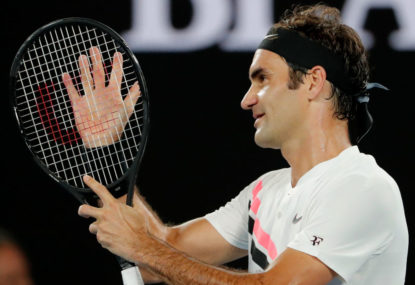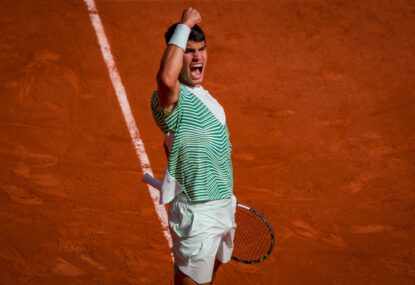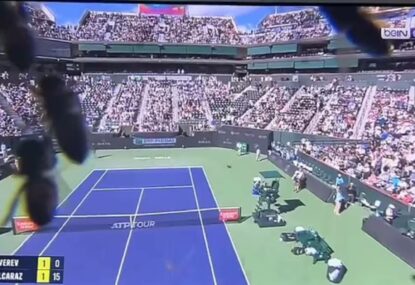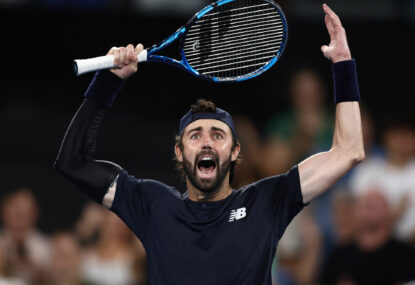A total of 20 grand slams. The oldest number one ever. 310 weeks at the top of the rostrum. Mistake?
Three of these apply to Roger Federer, without question. The latter, however, is perhaps the very last word you would use to describe the Swiss Maestro.
How can arguably the greatest player to ever grace the sport be associated with the word, ‘mistake’?
Look no further than the famed Wilson Wand.
For more than ten years up until 2013, Federer wielded the 90-square inch Wilson Pro Staff – something that was more akin to a racquet from the 1990s, rather than the 2000s.
And despite having a much smaller frame than his rivals, Martin Weston, the national junior coach manager for British tennis, points out that Federer still won an extraordinary 17 grand slams, between 2003 and 2012, with the outdated model.
“For Federer to have been the most successful player of all time with a 90-square inch racquet is remarkable and illustrates his other worldly talent,” he said.
“Most of the professionals use rackets that are between 95-100 square inches. That can allow players to have more margin for error, a larger sweet spot and easier power.
“Should he have switched earlier? You could argue yes, but why would you change when you win a record 17 slams with it?”
At that is the crux of the matter. Did Federer make a mistake in not changing to a more powerful racquet with a larger head size earlier in his career?
The 36-year-old himself admitted that the new racket helps him serve more consistently, gives him easier power, that it is not a problem for him to consistently attack with the backhand and that he used to shank too many balls with the old one.

Switzerland’s Roger Federer. (AP Photo/Vincent Thian)
Perhaps most telling of all, however, is his 4-0 record in 2017 against the man who has beaten him more than anyone else, Rafael Nadal.
Last year, Federer turned the heavily skewed rivalry on its head, simply because his old weakness on the backhand side became a weapon that Nadal had no answer to.
Former top 60 player turned television commentator, Justin Gimelstob, said: “The one thing that is obvious and undeniable is that the bigger racquet, with a bigger surface area, has helped Roger.
“This has been most notable on the backhand, especially against Nadal – a rival that had a pattern of play that was so prohibitive.”
He added: “I think Pete Sampras acknowledged at one point he should have gone to a bigger racquet or used different strings earlier and I think Federer would say the same thing based on the results but everything is about cause and effect and how players adjust.
“But he still had a huge amount of success. There is an element, not a stubbornness, but a belief in what got you there.
“Maybe you are a bit less likely to switch racquets when you have had so much success. Some players are more willing to tinker when they struggle. He finally made the adjustment and it paid dividends.”
The adjustment came, at first, in 2013. A back injury and a poor run of results, most notably with a second round loss at Wimbledon to 116th ranked Sergiy Stakhovsky, saw Federer drop to seventh in the world – his lowest ranking since 2002.
In relative terms, he had hit rock bottom. But Federer then made one of the most important, and bold, decisions of his career – to get rid of his faithful 90-inch Wilson Wand.
Following a great deal of tinkering with many prototypes, Federer found what he was looking for in a 97-square inch model in 2014.
Since the switch, the Fed Express has beaten Nadal in five of their last six meetings, which going by their head to head of 24-15 (to Nadal), is unprecedented.
When Nadal dominated the rivalry between 2004-2013, on occasions, Nadal served to Federer’s weaker backhand side 90 per cent of the time in some matches.
Since the racquet change however, that percentage has plummeted.
In last year’s Miami Open final, statistician extraordinaire Craig O’Shannessy revealed that, for the first time in their rivalry, it was a near 50/50 split for Nadal in going for the forehand or backhand.
For the first time in the Spaniard’s career, he was having to change his tactics to nullify Federer’s game.

Roger Federer has cemented his status as the GOAT. (AAP Image/Lukas Coch)
That success brought him a win-loss record of 52-5 and a 91 per cent winning ratio – the fourth best in his staggering career.
So was Federer’s astronomically good season last year down to him finally clicking with his racquet or the six-month lay-off in the second half of 2016 that left him well rested and primed for 2017?
Paul Annacone, who coached Federer between 2010 and 2013, said: “Players are creatures of habit. Roger is very open to change but the timing is important and vital to have a good period of time to get adjusted.
“I don’t believe he disadvantaged himself because he was confident and comfortable with the other racket.
“He had a good break from the game, great preparation, terrific clarity and confidence in his game plan, as well as terrific scheduling.
“When you are as talented as Roger and all those ingredients click – great things happen.”
In regards to whether or not it was a mistake to not change earlier, Annacone added: “Looking at his record I would say no. He’s done pretty well.
“If he plays Nadal on a slow high bouncing court it will still be a challenge – for the rest of the field I think he generally gets the ball in the strike zone he likes.”
Undoubtedly, Federer’s six month lay-off in 2016 gave him ample time to hone his genius skills.
Returning to the tour as fresh as he’d ever been and having more time than ever before to practice hitting through his backhand, is an argument that carries weight.
When Simona Halep’s current coach, Darren Cahill, was asked if Federer should have made the change earlier in his career, he said: “Yeah maybe, but he switched years ago and has only just now started cracking his backhand.
“(I think it is) more to do with coaching and staying fit.”
It is true that the new racquet did not bring instant success as he remained slamless between 2014 and 2016.
But when he did make the switch, Federer, according to Tennis Abstract, won 18 per cent of breakpoints where he tried to hit a backhand winner in 2014, 35 per cent in 2016 and a staggering 55 per cent in 2017.

Roger Federer (AP Photo/Pavel Golovkin, File)
Former tennis professional Doug Adler and coach Weston stressed how vital it is for a player to find the right racquet for them as if they don’t, the downsides can be disastrous.
“Getting the wrong equipment can be the difference between winning and losing. Grip size, tension, frame stability, the amount of repetitions on the shoulder and elbow joints – you cannot overstate the importance of the racquet,” said Weston.
Adler added: “A professional player’s racquet must be perfect and exact with each one.
“Without following these guidelines to the tee, a professional’s game could be dramatically different and altered from what is generally expected from their performance on the court if it is not absolutely right.
“I never took my racquet to bed with me but I used to hear rumours of certain players doing it when they were lonely.”
The debate may rage on, or not at all. But one thing we can be certain of, Federer is a gift to tennis and sport, regardless of what racquet he uses.






































































































